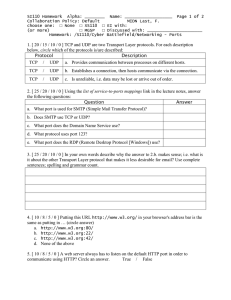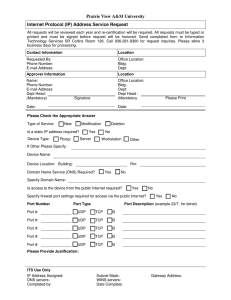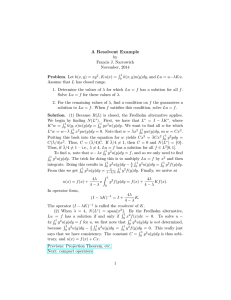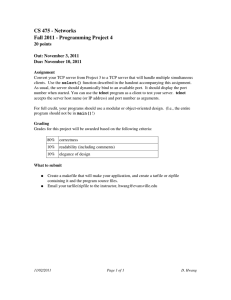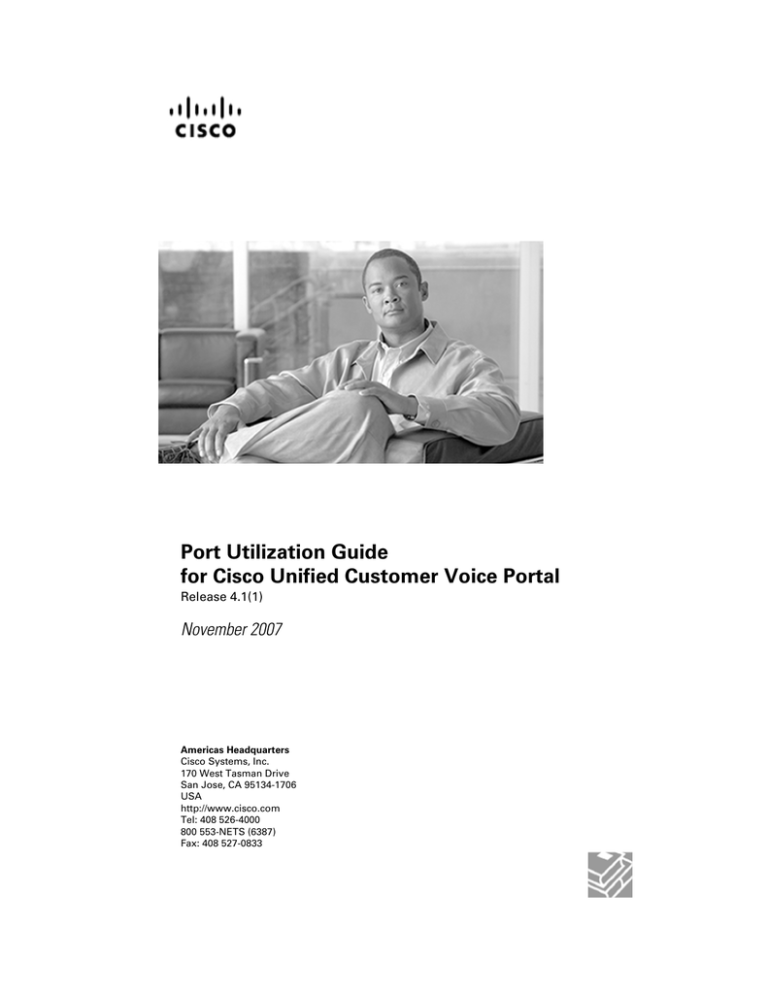
Port Utilization Guide
for Cisco Unified Customer Voice Portal
Release 4.1(1)
November 2007
Americas Headquarters
Cisco Systems, Inc.
170 West Tasman Drive
San Jose, CA 95134-1706
USA
http://www.cisco.com
Tel: 408 526-4000
800 553-NETS (6387)
Fax: 408 527-0833
THE SPECIFICATIONS AND INFORMATION REGARDING THE PRODUCTS IN THIS MANUAL ARE SUBJECT TO CHANGE WITHOUT NOTICE.
ALL STATEMENTS, INFORMATION, AND RECOMMENDATIONS IN THIS MANUAL ARE BELIEVED TO BE ACCURATE BUT ARE PRESENTED
WITHOUT WARRANTY OF ANY KIND, EXPRESS OR IMPLIED. USERS MUST TAKE FULL RESPONSIBILITY FOR THEIR APPLICATION OF
ANY PRODUCTS.
THE SOFTWARE LICENSE AND LIMITED WARRANTY FOR THE ACCOMPANYING PRODUCT ARE SET FORTH IN THE INFORMATION PACKET
THAT SHIPPED WITH THE PRODUCT AND ARE INCORPORATED HEREIN BY THIS REFERENCE. IF YOU ARE UNABLE TO LOCATE THE
SOFTWARE LICENSE OR LIMITED WARRANTY, CONTACT YOUR CISCO REPRESENTATIVE FOR A COPY.
The Cisco implementation of TCP header compression is an adaptation of a program developed by the University of California, Berkeley (UCB) as
part of UCBs public domain version of the UNIX operating system. All rights reserved. Copyright © 1981, Regents of the University of California.
NOTWITHSTANDING ANY OTHER WARRANTY HEREIN, ALL DOCUMENT FILES AND SOFTWARE OF THESE SUPPLIERS ARE PROVIDED
"AS IS" WITH ALL FAULTS. CISCO AND THE ABOVE-NAMED SUPPLIERS DISCLAIM ALL WARRANTIES, EXPRESSED OR IMPLIED, INCLUDING,
WITHOUT LIMITATION, THOSE OF MERCHANTABILITY, FITNESS FOR A PARTICULAR PURPOSE AND NONINFRINGEMENT OR ARISING
FROM A COURSE OF DEALING, USAGE, OR TRADE PRACTICE.
IN NO EVENT SHALL CISCO OR ITS SUPPLIERS BE LIABLE FOR ANY INDIRECT, SPECIAL, CONSEQUENTIAL, OR INCIDENTAL DAMAGES,
INCLUDING, WITHOUT LIMITATION, LOST PROFITS OR LOSS OR DAMAGE TO DATA ARISING OUT OF THE USE OR INABILITY TO USE
THIS MANUAL, EVEN IF CISCO OR ITS SUPPLIERS HAVE BEEN ADVISED OF THE POSSIBILITY OF SUCH DAMAGES.
CCVP, the Cisco logo, and Welcome to the Human Network are trademarks of Cisco Systems, Inc.; Changing the Way We Work, Live, Play, and
Learn is a service mark of Cisco Systems, Inc.; and Access Registrar, Aironet, BPX, Catalyst, CCDA, CCDP, CCIE, CCIP, CCNA, CCNP, CCSP,
Cisco, the Cisco Certified Internetwork Expert logo, Cisco IOS, Cisco Press, Cisco Systems, Cisco Systems Capital, the Cisco Systems logo, Cisco
Unity, Enterprise/Solver, EtherChannel, EtherFast, EtherSwitch, Fast Step, Follow Me Browsing, FormShare, GigaDrive, HomeLink, Internet Quotient,
IOS, iPhone, IP/TV, iQ Expertise, the iQ logo, iQ Net Readiness Scorecard, iQuick Study, LightStream, Linksys, MeetingPlace, MGX, Networkers,
Networking Academy, Network Registrar, PIX, ProConnect, ScriptShare, SMARTnet, StackWise, The Fastest Way to Increase Your Internet Quotient,
and TransPath are registered trademarks of Cisco Systems, Inc. and/or its affiliates in the United States and certain other countries.
All other trademarks mentioned in this document or Website are the property of their respective owners. The use of the word partner does not imply
a partnership relationship between Cisco and any other company. (0710R)
Any Internet Protocol (IP) addresses used in this document are not intended to be actual addresses. Any examples, command display output, and
figures included in the document are shown for illustrative purposes only. Any use of actual IP addresses in illustrative content is unintentional and
coincidental.
Copyright © 2007 Cisco Systems, Inc. All rights reserved.
Chapter 1
Cisco Unified CVP Port Utilization
This document describes the ports used in Release 4.1 of the Cisco Unified Customer Voice
Portal (Unified CVP) software.
This document is intended primarily for network administrators.
Port listings are presented in a table format. Where applicable, formulas are used so that you
can calculate the ports beyond instance 0.
Warning: The information this document provides is based on default configuration
settings. If you are working in a live network, ensure that you understand the components
installed and the associated ports in use.
Note: The Microsoft Windows 2003 Server default ephemeral port range (1025-5000) may
cause difficulties. A greater ephemeral port range (for example, 49152-65534, the ephemeral
port range for Microsoft Windows based MCS platforms) is recommended.
This section contains the following topics:
• Port Utilization Table Column Definitions, page 3
• Cisco Unified Customer Voice Portal Port Utilization , page 4
Port Utilization Table Column Definitions
The columns in the Port Utilization tables in this document describe the following:
• Server or Application Protocol:
A value representing the Server or Application and where applicable the open or proprietary
application protocol.
• Server Protocol/Port:
Port Utilization Guide for Cisco Unified Customer Voice Portal Release 4.1(1)
3
Chapter 1: - Cisco Unified CVP Port Utilization
Cisco Unified Customer Voice Portal Port Utilization
An identifier for the TCP or UDP port that the Server or application is listening on, along
with the IP address for incoming connection requests when acting as a server.
• Remote Protocol/Port:
The identifier for the TCP or UDP port that the remote service or application is listening on,
along with the IP address for incoming connection requests when acting as the server.
• Remote Device:
The remote application or device making a connection to the server or service specified by
the protocol; or listening on the remote protocol/port.
Note: The source port the local application or service uses to connect to a remote device’s
destination port is not specified because it is always dynamically assigned by the Operating
System. In most cases, this port is assigned randomly above TCP/UDP 1024.
Cisco Unified Customer Voice Portal Port Utilization
For Unified CVP Release 4.1.
Table 1: Cisco Unified Customer Voice Portal Port Utilization
Server or
Server Protocol/Port
Application Protocol
Remote
Remote Device
Protocol/Port
Notes
Unified CVP
CVP Messaging Layer TCP 23000 - 28000 (First
available)
CVP Subsystem
CVP Message Bus
communications
CVP SIP Subsystem, UDP 5060
SIP Proxy Server,
TCP 5060
Gateway, Unified
CM: SIP (Session
Initiation Protocol)
SIP endpoints
Listen port for incoming SIP
requests. Port is configurable.
VXML Server: HTTP TCP 7000
IOS VXML
gateways
VXML over HTTP.
Calls/sessions answered on port
7000 by HTTP server which
relays request to WAS on local
system port 9080.
VXML Server:
HTTPS
TCP 7443
IOS VXML
gateways
VXML over HTTPS.
Calls/sessions answered on port
7443 by HTTPS server.
VXML Server with
Tomcat
TCP 7005
Local machine
Port restricted to local access
only
VXML Server with
Tomcat
TCP 7009
Port Utilization Guide for Cisco Unified Customer Voice Portal Release 4.1(1)
4
AJP/1.3 Connector
Chapter 1: Cisco Unified CVP Port Utilization
Cisco Unified Customer Voice Portal Port Utilization
Server or
Server Protocol/Port
Application Protocol
Remote
Remote Device
Protocol/Port
Notes
CVP IVR Subsystem: TCP 8000
HTTP
Voice Browsers
VXML over HTTP
CVP IVR Subsystem: TCP 8443
HTTPS
Voice Browsers
VXML over HTTPS
CVP IVR Subsystem: TCP 8005
HTTP
Local machine
Port restricted to local access
only
CVP IVR Subsystem: TCP 8008
HTTP Admin
WAS and HTTP Server
communicate with each other
through HTTP Admin on port
8008.
CVP OPSConsole:
HTTP
TCP 9000
Web Browser
Web based interface for
configuring CVP components
CVP OPSConsole:
HTTPS
TCP 9443
Web Browser
Web based interface for
configuring CVP components
with SSL
CVP OPSConsole
TCP 9005
Local machine
Port restricted to local access
only
CVP OPSConsole
TCP 9009
AJP/1.3 Connector
CVP Resource
TCP 21
Manager FTP Server
Content Services Only opened by Resource
Switch
Manager residing on the same
machine as the CVP
OPSConsole
CVP Resource
Manager
CVP OPSConsole JMX communication from
OPSConsole to CVP Resource
Manager on remote device
TCP 2099
CVP Resource
TCP 32000 - 32999 (first
Manager Java Service available)
Wrapper
JVM instance
launched by
wrapper
CVP Resource Manager Service
Wrapper will no longer accept
connections after the first JVM
instance is connected.
MRCP
TCP 554
VXML gateway
MRCP session between gateway
voice browser and MRCP
server. This is the signaling
path; the media path uses RTP.
RTP
UDP 16384-32767
H323 H225 RAS
UDP 1719
H.323 applications Gatekeeper H225 RAS
(like H.323
Gateway and
H.323 terminals)
H323 H225
TCP 1720
H.323 applications H.225 signaling services
(like H.323
Gateway and
H.323 terminals)
UDP
16384-32767
Voice Media
Port Utilization Guide for Cisco Unified Customer Voice Portal Release 4.1(1)
5
Chapter 1: - Cisco Unified CVP Port Utilization
Cisco Unified Customer Voice Portal Port Utilization
Server or
Server Protocol/Port
Application Protocol
H323 H245
TCP ephemeral
Remote
Remote Device
Protocol/Port
Notes
H.323 applications H.245 signaling services for
(like H.323
establishing voice, video, and
Gateway and
data
H.323 terminals)
CVP SNMP
TCP 5700
Forwarder (AIX only)
CVP SNMP
subsystem
CVP SNMP Forwarder services
local requests from CVP SNMP
subsystem
CVP SNMP
UDP
SubAgent (Windows 5517,5519,5521,5523,5525
only)
CVP SNMP
subsystem
CVP SNMP SubAgent services
local requests from CVP SNMP
subsystem
CVP SNMP
subsystem
UDP
5516,5518,5520,5522,5524
CVP SNMP
SubAgent
CVP SNMP subsystem services
local requests from CVP SNMP
SubAgent
CVP SNMP Server
(AIX only)
UDP 8161
CVP SNMP
Forwarder
CVP SNMP Server TCP 32000 - 32999 (first
Java Service Wrapper available)
(AIX only)
JVM instance
launched by
wrapper
CVP SNMP Server Java Service
Wrapper will no longer accept
connections after the first JVM
instance is connected.
CVP ICM Subsystem TCP 5000
IPCC Enterprise
VRU CTI
(ICM/IVR
message interface)
Between CVP ICM Subsystem
(Call Server) and IPCC
Enterprise/ICM VRU PG. Port
is configurable.
Web Server: HTTP
TCP 80
Voice Browsers
Voice browsers fetches media
and "External VXML" files
from media server. Port is
configurable
IBM Informix
TCP 1526
CVP Reporting
Subsystem
Database Connection
IBM Informix Storage TCP 7939 - 7942 TCP 111
Manager
IBM WAS Console
IBM Informix Storage Manager
Services
TCP 9043, 9060
Cisco Support Tools
Support Tools
NodeAgent
TCP 39100, 39101
Support Tools Server: TCP 8188
HTTP
Port Utilization Guide for Cisco Unified Customer Voice Portal Release 4.1(1)
6
Support Tools
Support Tools Node Agent
Application Server services requests from the
Support Tools Application
Server
Web Browser
Support Tools Server services
HTTP requests from web
browser
Chapter 1: Cisco Unified CVP Port Utilization
Cisco Unified Customer Voice Portal Port Utilization
Server or
Server Protocol/Port
Application Protocol
Remote
Remote Device
Protocol/Port
Support Tools Server: TCP 8189
HTTPS
Notes
Web Browser
Support Tools Server services
HTTPS requests from web
browser
SNMP Master Agent UDP 161
SNMP
Management
Application
SNMP Master Agent listens for
requests from remote SNMP
management application and
sends reponses via UDP port
161.
SNMP Master Agent TCP 7161
Local SNMP
subagents
SNMP Master Agent listens for
TCP connections from local
SNMP subagents.
SNMP–Trap
UDP 162
SNMP Master
Agent
SNMP Master Agent sends
SNMP traps to SNMP
management application.
Syslog
UDP 514
Syslog protocol provides a
transport to allow a machine to
send event notification messages
across IP network to event
message collectors. Port is
configurable.
SSH
TCP 22
Port 22 for those who use SSH
instead of telnet on AIX.
Telnet
TCP 23
RDP
(TerminalServices)
TCP 3389
pcAnywhere
TCP 5631
Network Management and Remote Administration
UDP 5632
VNC
TCP 5900
TCP 5800
Windows Authentication and Remote Administration Ports
For more information, see: "Service overview and network port requirements for the Windows Server system” (Microsoft
Knowledge Base Article Q832017).
RPC
TCP 135
Port Utilization Guide for Cisco Unified Customer Voice Portal Release 4.1(1)
7
Chapter 1: - Cisco Unified CVP Port Utilization
Cisco Unified Customer Voice Portal Port Utilization
Server or
Server Protocol/Port
Application Protocol
NetBIOS Session
TCP 139
NetBIOS
NameResolution
TCP 137
Remote
Remote Device
Protocol/Port
Notes
UDP 137
NetBIOS
Netlogon/Browsing
UDP 138
SMB
TCP 445
UDP 445
DNS
TCP 53
UDP 53
NTP
UDP 123
Port Utilization Guide for Cisco Unified Customer Voice Portal Release 4.1(1)
8
Microsoft CIFS


